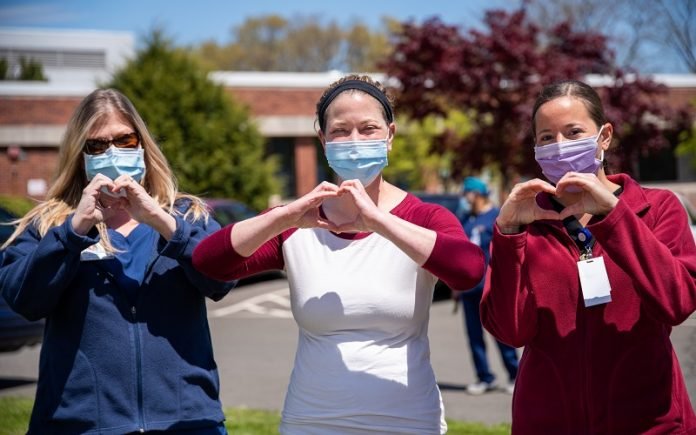
Mindsets developed in the first 10 days of the COVID-19 pandemic influenced people’s emotions and health behaviors – and ultimately predicted their well-being six months later, Stanford psychologists find.
Warnings of the fast-spreading SARS-CoV-2 virus in early 2020 threw everyone’s lives into chaos.
Many people wondered how the virus would affect their health, jobs, housing accommodations, and other aspects of their lives.
To cope with the turmoil and confusion of COVID-19, individuals quickly developed mindsets about it – simplified viewpoints that help a person create meaning, make predictions, and take action.
Now, Stanford University psychologists have found that mindsets formed about COVID-19 early on – within the first 10 days of the World Health Organization (WHO) declaring the disease a global pandemic – influenced emotions and health behaviors, ultimately affecting well-being months down the line.
The results stem from a study of more than 5,000 American adults surveyed at three specific points in time: the beginning of the pandemic, six weeks later, and again at the six-month mark.
The findings were published in the journal Social Science & Medicine.
“We had long thought that mindsets are formed in the midst of uncertainty,” said Alia Crum, an associate professor of psychology in Stanford’s School of Humanities and Sciences and senior author on the paper.
“So this current event, as unfortunate as it was, was the moment to study mindsets.”
Making up your mind
The researchers identified three mindsets that people could adopt:
- Catastrophe mindset: The COVID-19 pandemic is a global catastrophe that is wreaking havoc on our society.
- Manageable mindset: The COVID-19 pandemic can be managed so that people in our society can live life as normal.
- Opportunity mindset: The COVID-19 pandemic can be an opportunity for our society to make positive changes.
Crum’s group at Stanford, called the Stanford Mind & Body Lab, had studied these mindsets before.
“It really came from existing work that we were doing on illness mindsets,” said study lead author Sean Zion, who conducted the research as a PhD student in Crum’s lab.
“Since we had this work, and we knew that these mindsets were important, we adapted them to fit with the context of the COVID-19 pandemic.”
The goal of the project was not to characterize the mindsets of Americans, Crum explained.
Rather, the research team wanted to explore the relationships between mindsets and behaviors, emotions, and well-being.
On this score, the team found that the catastrophe mindset led to more negative emotions and less adaptive behaviors, while the opportunity mindset led to more positive emotions and more adaptive behaviors.
Those who adopted a catastrophe mindset reported worse well-being and higher levels of negative feelings, engagement in unhealthy behaviors, and experiences of isolation and meaninglessness on the last survey.
Agreement with the opportunity mindset, however, led to better well-being, more positive mood, more experiences of growth and connection, and fewer experiences of isolation and meaninglessness.
The majority of the research participants’ views aligned with one of these two mindsets.
The manageable mindset brought about more complex outcomes: It was adaptive on the individual level but maladaptive on the societal level.
“The manageable mindset helped individuals in terms of their level of mental health or their level of positive affect. It’s adaptive at the individual level to not engage with something that’s scary and uncertain, like a pandemic,” Zion explained.
“But collectively, it was also decreasing the behaviors we all needed to do – things like staying home, social distancing, and wearing masks.”
For some people, Crum said, the manageable mindset may have led them to deny the seriousness of the COVID-19 pandemic.
Furthermore, the scientists found that many participants viewed the pandemic as both a catastrophe and an opportunity – something they had not seen when studying mindsets in illness.
“In many ways, the pandemic did feel like a catastrophe,” Zion said. “But it also opened some new doors, some possibilities for slowing down, for reconnecting with family, for maybe rethinking career choices or how much you’re prioritizing work versus family.”
Now, the team is examining how early mindsets about COVID-19 impact individuals at a fourth time point: two years into the pandemic.
Things have changed drastically since the study’s last survey was administered in September 2020: Vaccines are now available, COVID-19 variants have spawned waves of infection, and people are growing even wearier of living with the virus.
With this two-year check in, Zion and his colleagues are exploring how early mindsets influence vaccine hesitancy and likelihood of catching COVID-19.
Mindsets, however, are just one piece of the puzzle, Crum explained. Personal experiences and circumstances during the pandemic, like the loss of a loved one and access to health care, also play a role in health and well-being.
As society learns to live with COVID-19, the researchers are designing and testing interventions to help people adopt useful mindsets for post-pandemic life.
Zion explained that health care has a long history of trying to improve health and well-being outcomes through brute-force changes to people’s behaviors.
Instead, altering mindsets and core beliefs may be a better way to produce desired results.
“We aim to help people acknowledge that the pandemic was a catastrophe, while also recognizing and realizing the opportunities it could open for people to make changes on individual and societal levels,” Crum said.
“These opportunities begin with one’s mindset.”
Written by Mckenzie Prillaman.



